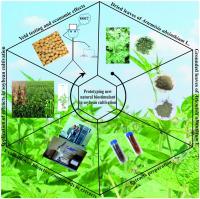Industrial Crops and Products ( IF 5.6 ) Pub Date : 2020-11-24 , DOI: 10.1016/j.indcrop.2020.113125 Agnieszka Szparaga , Sławomir Kocira , Ireneusz Kapusta , Grzegorz Zaguła

|
A number of alternative solutions to be implemented in the sustainable agriculture have appeared in recent years that not only improve crop yield but also reduce environmental pollution. They include, i.a., the use of biostimulants which are believed to stimulate plants growth. The objective of study was to produce a novel and natural biostimulant from leaves of Artemisia absinthium L. and to evaluate its properties under field conditions. This work is the first ever to report a complex approach to the use of plant extracts in soybean [Glycine max (L.) Merr.] cultivation based on the evaluation of not only crop yield but also economic effects. To accomplish this goal, two methods of aqueous extraction were applied, and the extracts obtained were administered to soybean plants, in the form of foliar application and soil treatment, at two stages of plant phenological development. Nineteen phenolic compounds were identified in the infusions, whereas eleven in the cold-soaked extracts. The total concentration of phenolics was over twofold higher in infusions. The extracts differed in terms of contents of macro- and microelements. The cold-soaked extracts were rich especially in macroelements (they had twofold higher contents of calcium, potassium, magnesium, sodium, phosphorus, and sulfur). The reported study proved the extracts examined can be successfully used as effective biostimulants in soybean cultivation. The improvement in soybean yield (in each tested combination) was noted as an effect of the application of the extracts from Artemisia absinthium, regardless of the method of their application. Nevertheless treating plants with cold-soaked extracts and infusions, in the form of foliar application, caused the average highest yield increase (31.41 % and 23.70 % respectively increasing over control). Considering both their effect on crop yield and also the economic concerns, they should be administered in the form of spraying. Our findings indicate that foliar application of both the infusions and the cold-soaked extracts brought similar profits from soybean cultivation (average 181 EUR ha−1). In addition, results allowed verifying the advanced hypothesis that extracts from Artemisia absinthium are candidates for ideal biostimulants. This study was the first to prove that this agronomic practice would represent a designed tool that would meet requirements of farmers by ensuring incomes from cultivation.
中文翻译:

苦艾蒿提取物的原型,因为它们具有生物刺激性,可提高产量,可增加农民的收入
近年来,出现了许多在可持续农业中实施的替代解决方案,这些解决方案不仅可以提高作物产量,而且可以减少环境污染。它们包括,例如,使用被认为刺激植物生长的生物刺激剂。研究的目的是从苦艾蒿的叶片中产生一种新颖的天然生物刺激剂,并评估其在田间条件下的特性。这项工作是首次报道了在大豆中使用植物提取物的复杂方法[ Glycine max[L.)Merr。]种植基于对作物产量和经济效果的评估。为了实现该目标,应用了两种水浸提取方法,并在植物物候发育的两个阶段以叶面施用和土壤处理的形式将获得的提取物施用于大豆。在输注液中鉴定出19种酚类化合物,而在冷浸提取物中鉴定出11种。输注中酚类的总浓度高出两倍以上。提取物的宏观元素和微量元素含量不同。冷浸的提取物尤其富含大量元素(钙,钾,镁,钠,磷和硫的含量高出两倍)。报道的研究证明所检测的提取物可以成功地用作大豆栽培中的有效生物刺激剂。大豆产量的提高(在每种测试的组合中)被认为是施用大豆提取物的效果。苦艾蒿,不论其施用方法如何。然而,以叶面施用的形式用冷浸的提取物和浸液处理植物,导致平均最高增产(分别比对照增加31.41%和23.70%)。考虑到它们对作物产量的影响以及经济方面的考虑,应以喷洒的形式进行管理。我们的发现表明,叶面注射液和冷浸提取物都从大豆种植中获得了相似的利润(平均181 EUR ha -1)。另外,结果允许验证从苦艾蒿中提取的高级假说是理想的生物兴奋剂的候选人。这项研究是第一个证明这种农艺实践将代表通过确保耕种收入满足农民需求的设计工具。









































 京公网安备 11010802027423号
京公网安备 11010802027423号